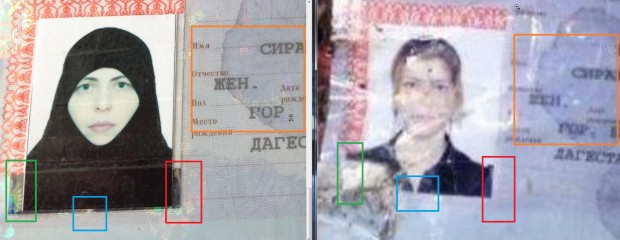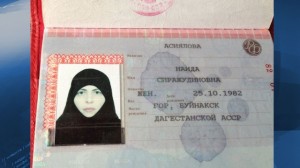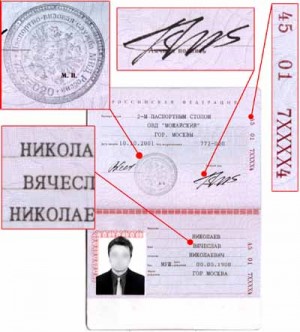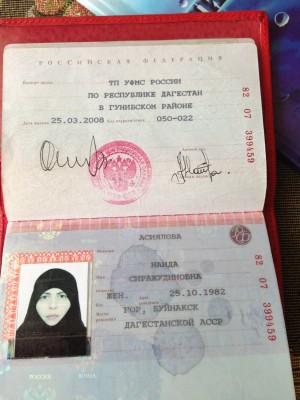An explosion has ripped through a bus near the southern city of Volgograd (map), in the volatile North Caucasus region.
Updates are below. Click here to jump to the end of the page where we have posted summary and background information.
October 22, 1945 GMT: The passport mystery continues (see previous updates below), but a close examination of the two passports yields some clues. Below, we have posted a higher-resolution picture of both passports (click to see a larger version).

What we are looking at may actually be the exact same passport. First, if we look at the passport on the left, the hijab passport, it is a clear fake. The orange design on the top and left do not overlap the image. The image is higher than the rest of the passport, as it it were glued on. The border of the picture is too small for the box it is in. Looking even more closely, we see that the hijab picture is clearly glued ontop of the picture on the right. Note that the shoulders of the picture on the left and right correspond exactly. Also, on the right, Asiyalova is wearing a shirt that is open at the margins, and we can see the opening in her shirt (the blue box). Furthermore, the “stains” on the text, and the text itself, is exactly the same from photograph one to photograph 2. We’ve looked at hundreds of pictures of Russian passports, both internal passports and external ones, and nothing like those stains appear on any other passport we’ve seen.
There are two possibilities that we can think of:
1. Someone copied the exact same passport, suspicious waterstains and all, and then altered one of them. This theory has a glaring problem – copying the entire passport is a complex and elaborate process, but the picture is so amateurish that this theory makes no sense. “Cui bono,” who benefits from having an exact duplicate of a passport with a terriblly fake picture. After all, if the FSB or KGB wanted to fake a passport, surely they have that capability.
2. These are actually, literally, the same passport. Nadia Asiyalova likely added the hijab picture herself, which is why it is so badly done.
But if this second theory is true, then how is the passport pristine in one picture and damaged in the second? Professor Mark Galeotti made some good points earlier (update 1617). Perhaps the passport was not damaged at all in the explosion. Perhaps the authorities released the picture of the passport as it was found, but there were too many skeptics, so they removed the fake photograph and damaged the passport. If this is true, it was an amateurish and ill-planned move, likely done by someone fairly low in the command chain. But it may be the only plan that makes any sense anymore.
October 22, 1730 GMT: Referencing our last update, below, the news agency Slon suggests that there are several problems with the article we’ve just summarized from BestToday. According to Slon:
1. Passports have been allowed in both black and white and color since 2006.
2. Photos do appear to have been glued on top of other photographs, but it could have been Asiyalova herself that did the edits. Earlier, the Russian press reported that it was Asiyalova’s intention to continue on to Moscow. Perhaps she knew her passport would not get her past police, which is why she stopped at Volgograd?
3. Though BestToday was correct about the rules concerning head dress, sometimes these rules are simply not met.
4. Contrary to the claims by BestToday, the codes on the passport are indeed used for Dagestan.
5. The placement of the names seems to vary often between issuing offices. Both color and black text are used.
6. Relating to a point made outside of BestToday’s numbered questions, as to why there would be what appeared to be a stain on the laminated photo page of a passport, Slon replies that the other side of the page is unprotected so as to be left clear to be updated for divorce details.
Still, however, problems remain. The “blotches” appear to be identical in both passports, which would suggest perhaps a watermark, though we’re not familiar with any that match that design. In fact, the passports seem identical, except for the obvious damage, and the picture.
Sean Guillory has also written about the passport, and among his other points he asks these hard questions:
So why the initial fake passport? True, the Russian media is under the same pressures media from other countries. They have to get information out fast, and the fastest juiciest news the better. However, Life News is an animal on its own. It’s known for its half-truths, police connections and general subterfuge. It’s well known that the siloviki use Life News to generate black PR to smear oppositionists. Clearly they–Life News and/or the police wanted to get “proof” of Asiyalova’s identity out there. But why? I’m sure there’s a much more surly back story to all this. But on the surface in releasing this counterfeit passport, Life News, the cops, or whoever once again undermined what the Russian police have little of: public trust. Could’ve that been the point?
October 22, 1650 GMT: Yesterday, we mentioned how quickly information was released by the police, including details about the perpetrator, Nadia Asiyalova, her husband, and the specific device used in the attack. What finally cleared up a lot of the discussion, whoever, was when a picture of the passport belonging to the bomber, allegedly found at the scene of the crime, was published by the Russian press. The narrative was that the picture, showing a pristine passport and a woman wearing a hijab, had been shown to the press by the police.
There is a new problem. Apparently, a new picture, published today, shows another passport belonging to Nadia Asiyalova, but this time the passport has a different picture, and is full of holes, likely the result of the bombing:
If this, from @Dobrokhotov via @ARothNYT is the real passport of alleged bomber. What was passport shown yesterday?pic.twitter.com/u58DywrLiI
— Daniel Sandford (@BBCDanielS) October 22, 2013
So why are there two passports, with two different pictures, in two completely different conditions? The Russian newspaper “BestToday” is asking the same question, and below we have summarized their points: 1: The original photo appears to be in color, albeit faintly, “if color, then when was the passport issued?” [we are researching this aspect right now – Ed.] 2: “Am I the only one that sees that the photo of the woman is lying on top of someone else’s passport, covering the original face?” [In fact, there do appear to be creases on the original picture – Ed.] 3 “In the RF, can one be photographed covered up like this [wearing a hijab]? What about the law of 2003, which permits one to be photographed in a headscarf, but not covering the oval of the face?” 4: Their 4th point discusses the numbering on the passport but it’s not clear exactly what they are referencing. 5: As far as the author remembers, the first characters of the first and second names should be vertically aligned. They are not. 

 We’re still investigating, but human rights activist Garry Kasparov is asking the same questions we now have: https://twitter.com/Kasparov63/statuses/392690461183184896
We’re still investigating, but human rights activist Garry Kasparov is asking the same questions we now have: https://twitter.com/Kasparov63/statuses/392690461183184896
Here is link (in Russian) with pictures of both passports. Of course both could be fake but the first obviously. http://t.co/odv5aV9Nxm
— Garry Kasparov (@Kasparov63) October 22, 2013
Dateline: All updates below are from October 21st.
2040 GMT: Yekaterina Golod, head of the Volgograd Governor’s press office, has released a statement saying that the bomb was packed with shrapnel. A bolt was found lodged in the heart of one of the victims, but surgery was successful. Meanwhile, the Vice-Chairman of the State Duma and LDPR leader, Vladimir Zhirinovsky, has said that it is possible that this attack was conducted by minorities as revenge for the anti-immigrant riots that rocked southern Moscow last weekend.
I do not rule out that the attack is in retaliation for Biryulyovo. Someone could have paid to commit the terrorist attack in Volgograd. They could come to Volgograd, find there the right people, and do the whole thing. Perhaps they did [find terrorists to conduct this attack] in the people from the North Caucasus, Dagestan. I believe that it is necessary to further strengthen the FSB bodies and give them more rights in the fight against terrorism in Russia.
1617 GMT: The Interpreter’s Editor-in-Chief, Michael Weiss, has interviewed New York University Professor Mark Galeotti about today’s bombing in Volgograd, and the speed at which the authorities reported details surrounding the attack:
The Interpreter – The first thing people are going to wonder about is how the authorities managed to compile so much detailed information on the suspect so quickly, even down to the explosive device she used. Is the Russian CSI protocol really that fleet-footed, or is it time to revisit the Moscow apartment bombings?
Galeotti – The effects of bomb blasts are unpredictable and tend to push rather than obliterate, so it is by no means incredible that the bomber’s identity documents were recovered from the scene (and once they correlated that to the name of a known militant, then I can understand the FSB’s rush to identify). Likewise, from experience I know that a smart technician can make a pretty good estimate of the type of explosive device used. In many ways the evident weaknesses in Russian law enforcement can sometimes blind us to their capabilities, which include being pretty good at the kind of routine follow-up operations involving lots of people, painstakingly searching scenes of crime, and following up on leads. No need yet to assume some deep, dark conspiracy at work!
The Interpreter – Reports now say the bomber was from Dagestan. What sort of measures did the Russian government take following the Boston marathon bombings to round up or interrogate terrorist cells in the region?
Galeotti – “Counter-terrorism” in Dagestan is essentially a constant and often hard-fought counter-insurgency operation as much as anything else. In other words, instead of locating and running down handfuls of urban conspirators hiding in the midst of a generally loyal or neutral population, the federal authorities are facing a range of threats, from lone-wolf terrorists to conspiratorial cells, to rural guerrilla bands, to networks linking all of these. In the past couple of weeks, after all, we’ve seen bombs defused, ambushes of government forces, shootouts with insurgents, and arrests. However, while Ramazan Abdulatipov, the Kremlin’s man in Dagestan, is publicly committed to wiping out the insurgency, he seems even more eager to consolidate his own power through arresting rivals and reshuffling the state apparatus. In the process, he risks alienating the traditional clan structures, which are still so strong in Dagestan, and also throwing the local security apparatus in disarray. So, while the Russians have ramped up their intelligence and security operations in Dagestan of late, albeit more because of Sochi than Boston, it is an open question of how far their efforts are going more than simply maintaining a violent and volatile status quo, not least given that Abdulatipov’s personal ambitions may well be contributing to the mess.
The Interpreter – I know you’ve looked at the possibility of attacks against the upcoming Sochi games emanating from Russia’s ‘internal abroad’. How easy is it for an attack such as today’s to be replicated during the Olympics? What kind of precautions are the security services taking?
Galeotti – A massive security operation is underway for Sochi, now predicted to cost an estimated 57.8 billion rubles (US $3 billion) and which will involve 25,000 police, 8,000 other security troops and 20,000-30,000 regular soldiers, along with all kinds of other assets, from specialized naval vessels configured to spot divers, to drones and fighter planes in the skies. Beyond that, Sochi is already at the heart of a security zone within which enhanced measures are in place, and people wanting to enter it will have to pass FSB controls. All very impressive, but no security measures are proof against human error, corruption and simple bad luck, and Russia has been prone to all three in the past (witness Chechen terrorist Shamil Basayev‘s ability to bribe and bluff his way past checkpoints to Budennovsk in 1995, accompanied by truckloads of gunmen). With an estimated 70,000 staff working on the Games (including 25,000 volunteers from across Russia) and an expected 3.85 million visitors, there is no way that all of them can or will be fully screened, especially as of late we have seen cases of ethnic Russians converting to militant Islam. Even if they can’t take guns or bombs into the security zone, there is scope to take the former from security forces, or to opportunities to use impromptu weapons, from trucks to molotov cocktails. After all, a terrorist attack needs not to be especially large or successful to have a disproportionate political impact. The odds are in the Russians’ favor. They are throwing massive resources into securing the Games, they are not being held in the middle of a busy city, and we can’t ignore the professionalism and doggedness of many within the security forces, so the chances of a successful attack are low. However, it is worth noting that the concentration of forces and resources on Sochi inevitably takes them away from elsewhere, and so Sochi may make terrorism elsewhere in Russia easier.
1457 GMT: According to the Russian news agency RIA Novosti, the bus was carrying many college students, and most of the victims were younger people under 30 years of age. Also, the Russia media has released this picture of the photograph of the suspected bomber. The apparently pristine condition of the passport won’t assuage those who doubt the official reporting on this event:
PHOTO: Volgograd suicide bomber identified as 30-year-old female recently converted to Islam http://t.co/icjnQYIhsM pic.twitter.com/2zCxt7Y3u4 — RT (@RT_com) October 21, 2013
1434 GMT: There is significant skepticism that the Russian authorities could have so many details concerning this case so quickly. The police have even described what kind of bomb was used, saying that it contained grenades. This kind of information typically takes a long time to unearth. Also, the identity of the suspected bomber was also quickly released. However, Vesti News has reportedly shown the passport of Nadia Asiyalova (now the dominant spelling): https://twitter.com/BBCDanielS/statuses/392296189422350336
Also, Vesti has published more photographs, including a graphic picture that appears to show at least one bloody victim still inside the wreckage.
1405 GMT: Now we have a name for the suspected suicide bomber:
https://twitter.com/VoiceofRussia/statuses/392284375573733376
Obviously, however, there are some conflicting reports in the media, including about the age of the bomber:
The 20-year-old female suicide bomber in Volgograd was from Dagestan, wife of terrorist, suffered from a bone disease @lifenews_ru reports — Alec Luhn (@ASLuhn) October 21, 2013
According to both Vesti.ru and rosbalt.ru, Nadia is 30 years old, from Dagestan, and was suffering from a debilitating disease of the bones (possibly cancer). The suspected bomber’s husband is Dmitry Sokolov, a 22 year old from Moscow who has been missing since 2012. Dmitry reportedly moved to Dagestan, fell in love with Nadia, disappeared from his family and his work, studied Arabic in Cheratnovo, and now calls himself Abdul Jabbar. He is wanted for his suspected connection to a bombing in Makhachkala. In May, he was suspected to have helped construct suicide vests for a bomber, Madina Aliyeva, who blew herself up near the Interior Ministry in Dagestan, killing 12 and injuring 17. Note, there seem to be three different spellings being used by the Russia media of Nadia’s last name (with differences in the Russian language as well): Asialova, Asiyalova, and Akhiyalova. Hopefully this will sort itself soon.
1340 GMT: New video has emerged that appears to show the explosion on the bus: https://twitter.com/paulsonne/statuses/392283735405514752
According to multiple Russia-bureau reporters, there is new information that police have released about the reported suicide bomber.
https://twitter.com/ARothNYT/statuses/392282248021426177
https://twitter.com/MarkGaleotti/statuses/392280699874836480
This information has come out very quickly, and there are skeptics as to the official account that is now emerging:
As some in Russian Twittersphere have asked, Why would #Volgograd bomber bring her documents with her & blow up bus in empty part of town?
— Alec Luhn (@AlecLuhn) October 21, 2013
Summary and Background Reuters reports that at least 5 people are dead:
The explosion also wounded 17 people, seven of whom were in grave condition, a spokesman for the local investigators said. After a series of conflicting reports about the cause, the National Anti-Terrorism Committee said it was a bomb. “Today at 2:05 p.m., an unknown explosive device detonated on a passenger bus in the city of Volgograd, causing human casualties,” the committee, Russia’s top counter-insurgency agency, said in a statement.
Here is a video of the bus after the incident: https://twitter.com/NCaucasusCaucus/statuses/392278502549880834
There is also a report from Sky News’s Tim Marshall that investigators now say that 6 people are dead after a female suicide bomber detonated a device. We are seeking additional details.
As to motive, that remains unclear because it is unclear which group conducted this attack. Ethnic tensions are running high in Russia, as anti-immigrant pogroms have occurred in the Caucasus, St. Petersburg, and Moscow. There are also concerns that, as the Sochi 2014 Winter Olympics draw near, the terrorism threat will increase significantly.
For background, see our analysis of ethnic tensions in the North Caucasus, our analysis of Moscow’s recent race riots as well as the Kremlin’s response.
We will continue to update this story as we find more details.